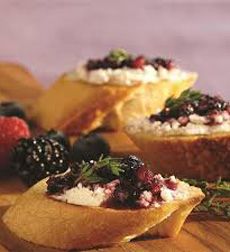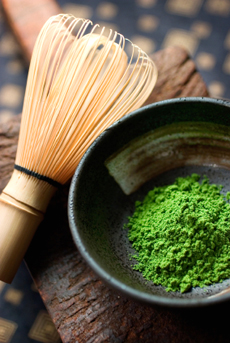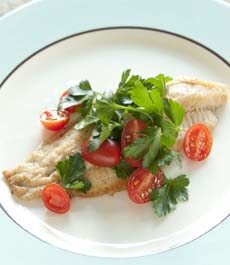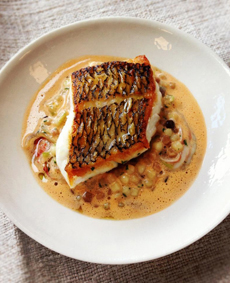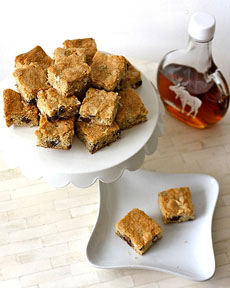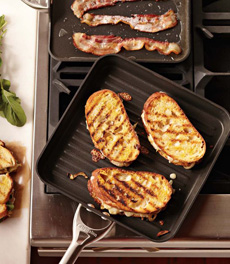
[3] These Crustless Breakfast Tarts with Mushrooms and Goat Cheese are elegant enough for a special occasion (photo © Kalyn’s Kitchen. |
|
Kalyn of Kalyn’s Kitchen was inspired by a new tart pan to make breakfast tarts, combining cream, eggs, goat cheese, green onions, mozzarella, mushrooms and Parmesan. You can also use a muffin pan or individual gratin dishes.
There’s no pastry, so you can save the carbs for your toast or muffin.
The tarts will keep in the fridge for at least a week and can be reheated in a microwave or hot toaster oven. It only takes a about 70 seconds in the microwave; don’t microwave too long or the eggs will get rubbery.
RECIPE: CRUSTLESS BREAKFAST TARTS WITH GOAT
CHEESE & MUSHROOMS
Ingredients For 6 Breakfast Tarts
4 ounces fresh goat cheese (e.g. from a log), crumbled and softened
1/4 cup milk, half and half, or cream
2 tablespoons finely grated Parmesan
12 ounces crimini (baby bella) mushrooms, washed and sliced
2-3 teaspoons olive oil (depending on your pan)
1 teaspoon Spike Seasoning (see below, or use any all-purpose seasoning blend that’s good with eggs)
Fresh-ground black pepper to taste
8 eggs, beaten
2 green onions, thinly sliced
6 tablespoons mozzarella cheese, crated
|
Preparation
1. REMOVE the goat cheese from the fridge, cut off 4 ounces, crumble and place in a bowl to start to soften. Preheat the oven to 375°F/190°C. Spray the tart pan (or other cookware) with olive oil or nonstick spray.
2. USE a fork to mix the milk/cream into the softened goat cheese; then mix in the Parmesan. Beat the eggs in a different bowl and mix 1/3 at a time into the goat cheese mixture, stirring each time you add more egg. (The mixture doesn’t need to be completely smooth.)
3. WASH and pat dry the mushrooms and slice about 3/8 inch thick. Heat the oil in a large nonstick frying pan to avoid crowding the mushrooms. Cook the mushrooms over medium-high heat until all the released liquid has evaporated and mushrooms are starting to brown, about 10 minutes. Divide the mushrooms between the wells in the tart pan.
4. POUR the custard mixture over the mushrooms and gently stir to distribute the mushrooms evenly. Sprinkle a generous pinch of green onions on top of each tart, followed by one tablespoon of grated mozzarella.
5. BAKE for 25-27 minutes (or slightly longer if you don’t have this tart pan and your tarts are a little thicker). Cook just until the tarts are starting to barely brown on the top; the custard mixture should be soft. Serve hot.
SPIKE SEASONING
Spike Seasoning was created by more than 50 years ago and still has a huge fan base; it gets a five-star review on Amazon. You can buy it online or at retailers nationwide. There’s also a salt-free, gluten-free version.
Original Spike Seasoning a blend of 39 ingredients: Salt and sea salt, de-fatted nutri-soy granules, granular toasted onion, nutritional yeast, granular garlic, celery root granules, ground dill, horseradish granules, mustard powder, lemon peel, orange powder, parsley flakes, red bell peppers, green bell peppers, white pepper, rose hips powder, summer savory, mushroom powder, safflower, parsley powder, white onion powder, spinach powder, tomato powder, sweet Hungarian paprika, ground celery seed, cayenne pepper, ground turmeric, ground cumin, ground ginger, ground coriander, ground fenugreek, ground cloves, cinnamon powder, oregano, tarragon, sweet basil, marjoram, rosemary and thyme.
If you don’t see it in the spice section, look near the health foods.
MORE GOAT CHEESE BREAKFAST RECIPES
Breakfast tarts with mushrooms and goat cheese (recipe)
Goat cheese scrambled eggs (recipe)
Goat cheese and fresh herb omelet (recipe)
Goat cheese and prosciutto strata (recipe)
Grilled goat cheese sandwich with honey and figs (recipe)
Poached eggs on toasted baguette with goat cheese (recipe)
|
